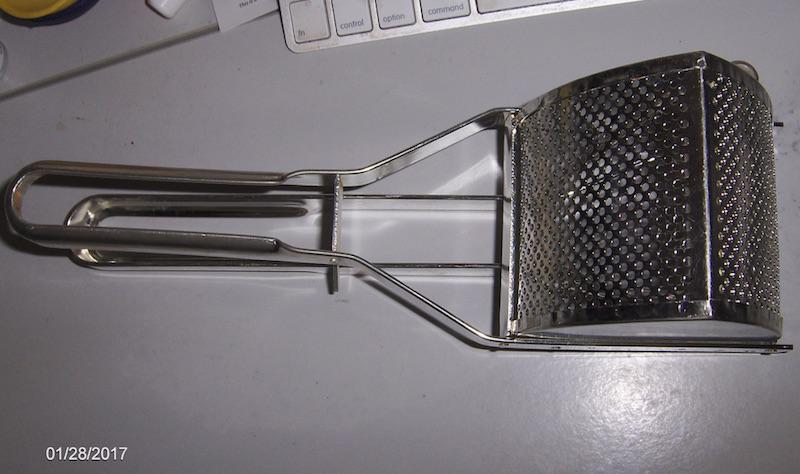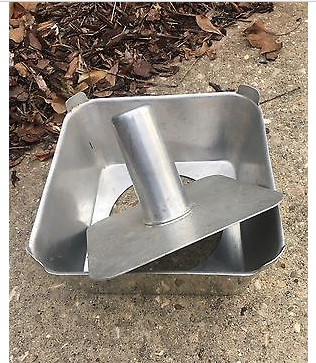-
Posts
11,034 -
Joined
-
Last visited
Content Type
Profiles
Forums
Store
Help Articles
Everything posted by andiesenji
-
There was a multi one offered quite a few years ago - but it was metal and was for a grill or oven. I see they do have a 4-dog unit which I guess is for the microwave. I think the one I saw back in the 80s ? was for 6 "dogs" . There was one on ebay a couple of years ago.
-
Those look wonderful, Shain. I was going through my recipe folder of "MAKE AGAIN!" things and came across some other things. I made a dish with sausage and apples - spiced with za'atar and served over noodles, which I marked with 5 exclamation points. Also "little" meatballs flavored with the spice. I usually buy one of the mixtures they offer at the middle eastern market here in town but the last batch I got from Nuts.com and I was quite impressed. It is very fresh tasting and has what I consider an excellent ratio of ingredients.
-
That's it. I also used it with other meats. I used it on turkey legs with a long, slow braise.
-
Years ago I got a recipe out of Sunset Magazine for Chicken with Za'atar and Lemon. I have prepared it many times and it is fantastic. I made it for a potluck dinner for my computer club and I think everyone there pulled it up on their devices. I'll look for the link.
-

Yard Sale, Thrift Store, Junk Heap Shopping (Part 3)
andiesenji replied to a topic in Kitchen Consumer
Keeping an edge on knives while out in the field can be tricky. On one trip in the early '70s, I had "help" with my packing for a deer hunting trip to St. George, UT. I guess my husband thought the case in which I had my sharpening stones was too "heavy" for my backpack and left it out. When I had to field dress a buck and had done most of the basic stuff, I wanted to hone the edge - no stone. Fortunately, Utah has local rocks called "novi" something - that our Indian guide found and it worked a treat on both my knives. I kept it for years until I lost it in one of my moves. Found the name of the stone: Novaculite. -

Yard Sale, Thrift Store, Junk Heap Shopping (Part 3)
andiesenji replied to a topic in Kitchen Consumer
I've got a fifty-year-old boning knife made by Dexter that is about 1/3 narrower than it originally was. My dad gave it to me when I was hunting. I used a stone to sharpen it and it held an edge well. Carbon steel so I kept it wrapped in an oil-soaked cloth between uses. -

Yard Sale, Thrift Store, Junk Heap Shopping (Part 3)
andiesenji replied to a topic in Kitchen Consumer
It is a great book, as are her others. I have at least three of her books, mostly purchased in the '70s and '80s, though I did get one just a few years ago, that I think was published in the '90s. I got to meet her in the '80s at a book signing at Brentano's in Westwood Village. She was very gracious, gave a lovely talk and there were free recipe card sets with recipes that were going to be in her next book. By the way, the box is "out for delivery" !! -

Yard Sale, Thrift Store, Junk Heap Shopping (Part 3)
andiesenji replied to a topic in Kitchen Consumer
I have a bunch of these - restaurant ware made by Hall China, Shenango, Syracuse, etc., I used to use them for pot pies, top crust only. -
We seem to have an invader. Here's the other type of ricer I have - these handles are killers for me. It is going out in the trash.
-
-
I have several Angel food pans with removable bottoms. I have my grandmother's from the 1940s. WEAR-EVER ALUMINUM with a tapered center stem. They also made a square one. I recently saw one on ebay. And I have a newer one like this. Chicago Metallic
-
I've had Excaliburs for many years. The first one I bought was a 5-tray and it was so successful I then got a 9-tray and then a second one. I wore out the 5-tray, gave away one of the 9-trays when I was no longer doing as much gardening. The thing works beautifully as a proofing box with all the trays removed. If the dough is exposed the surface will dry out but a damp cloth over the top will keep it moist, if it requires a long proof - heavy whole wheat, seeded and fruited breads - I check and spritz the cloth with water one or two times. I had forgotten just how long ago I got the first Excalibur - it was before I moved up here in 1988. Not long ago a friend reminded me that we went to the L.A. Country Fair and a vendor was demonstrating them in a large booth where VitaMix blenders were also being demonstrated and in fact they were preparing the fruit for fruit leather in the VitaMix to be finished in the Excalibur. I had one of the older VitaMix - one with the stainless steel jug that has a spigot at the bottom, but the newer one had a much larger jug and a more powerful motor. I bought a VitaMix and the 5-tray Excalibur and I think it was about 1983 because I was still driving a Toyota pickup with a camper shell. After I moved up here and had a large garden, I found the 5-tray was not adequate and bought a 9-tray - I think in 1990 and a second one a couple of years later from Pleasant Hill Grain - from an ad I saw in Mother Earth News. This was prior to the internet - the phone service was excellent and I have purchased many other appliances and my Berkey water purifiers from them. I used to make large batches of candied ginger - 10 to 15 pounds at a time and putting it in the Excaliburs speeded up the process after the candying so I did not have trays of sticky stuff all over the kitchen. Same with candied citrus peel and glacé fruits. Jerky cures much faster with the air circulating and at the highest temperature. I also made dehydrated liver chunks when I was still showing dogs, for "bait" while showing them.
-
They are known as potato "ricers" in the U.S. I have several, one is about 80 years old. I have found that the RSVP one is easier for me to use now that I have arthritis in my hands. The handles are larger and easier to grip. I have one like yours and I have a different style that I use to use a lot - a Norpro - but the handles are difficult to grip and it doesn't have a hook to rest on the edge of a bowl.
-
I purchased all my Cambro containers from Smart & Final. Great prices and they included the lids, sold the largest 22 qt singly but the smaller ones were also "bundled" 4 of the 6 or 8 quart with lids. 2 of the 12 and 18 with lids, the smaller ones in larger bundles. 10 of the 1 quart and I think 6 or 8 of the 2 quart. I bought a bunch when I was catering. I still have almost all of them and they are still good.
-
Webstaurantstore mates the lids to the correct containers - as on this page the 6 and 8 quart containers. Or, as you can see on this page the 22 quart container and below it the lid that fits it and the 12 and 18 quart containers.
-
You also need a frame on which to stretch the muslin - which has to be washed before to remove the sizing, otherwise the beeswax won't stick well and will pop off in spots. I use "butter muslin" since I have a goodly supply from when I ordered a bunch back in the '90s when I was making cheeses. I was a bit over ambitious and ordered far more than I could use back then. It comes in handy for lots of things, including this. Otherwise, fine, unbleached, 100% cotton muslin is good. I have canvas stretchers which fit together without tools, although you can use screws to permanently construct them. They are cheap and the wood is soft enough to use thumbtacks (on the outside edges, in case you have never used them before. The friction of rubbing the beeswax into the material is usually enough to soften it or you can dip it in warm water. I use a sheet pan turned upside down on which to iron it.
-
Don't forget the Atlantic seaboard and Gulf coast specialty - Shrimp and Grits. I can't eat seafood but I know some folks here on eG who are "enthusiastic" about this dish.
-
White "dent" corn was the preferred variety where I grew up. Yellow corn was "horse corn" or feed corn, not for human consumption. Although a lot of farmers brought plenty of yellow corn to the mill to be ground into coarse meal - this was for an "alternative" use which involved some sugar, water and heat...
-
I don't think it can be called "hominy" unless it has been treated. I know there was one plant in Tennessee that had photos of the process on their web site a couple of years ago. I know that when the grist mill my grandpa owned was first built, just after the Civil War, they used wood ash to process the corn. When I was little the "ash house" a shed on the back of the building, was still there but only used for storing wood and coal for the "cookers" and the old balance beam scale was still there, to measure the amount of ash brought in by the local people who either got paid in coin or "laid up credit" to be used later when they needed to have corn ground. The mill for grinding hominy was separate from the main mill for grinding regular corn. The millstones had deeper grooves that spiraled in. The regular mill had grooves that went strait in from perimeter to the center hole and were shallower at the outside and slightly deeper at the center. They started using lye about the the turn of the century when "refined" lye became readily available and not as costly as before. The use of wood ash gradually declined, but some people still used it at home. This is the process. We kids were fascinated with how it worked - it was actually 4 stories - the basement, where the drive shafts came in from the outside and hd to be constantly tended, to make sure the gears were lubricated. The main floor where the bagging was done as the finished meal came down into the hoppers. The mill floor and above that the floor we were forbidden to ever go, that contained the equipment that lifted and lowered the stones, the feed hoppers and kept the shafts aligned. There were holes in the floor in that room and all that machinery made it like a maze. And it was hot in the summer. Grandpa would not let any of the men work up there more than 2 hours then they had to trade off with another.
-
Grits is a SOUTHERN thing, so yes to Texas but if you want to get into deep grits country, the Carolinas, Georgia, Alabama, Mississippi, Louisiana and the next tier up are the heaviest consumers. Western Kentucky, where I was born and raised, was a major grits producer. And it IS different from corn meal. White dried corn (mostly white) was soaked in lye water - a tricky process - then washed and dried in "shaker" pans over a very low fire. These were rectangular "pans" about 6 inches deep and as I recall, about 3' wide and 4' long, hung on chains so they could be raised and lowered and shaken to agitate the hominy kernels. When dry, it was bagged in 50 pound burlap bags that were sold as is if people wanted to cook whole hominy, or some people would buy a bag and have it ground at the grist mill into grits, fine, medium or coarse, and then it was bagged in cloth bags. That was the stuff that was cooked with water and salt to make the breakfast staple. So now you know that when people tell you that cornmeal and polenta and grits are all the same, you can tell them that is not so.
-
Here's one recipe for stuffed hush puppies. You can put the batter around anything that isn't too wet. Mozz should work just fine. When I was little, cook made hushpuppies stuffed with chunks of apple or peach, even dried fruits in the winter. I have made them with "poppers" jalapeno peppers stuffed with Mexican cheese inside the hushpuppy coating.
-
Because so many men from farms were in our military, POWs were sent to work on farms to help food production. My grandfather had a very large farm and employed a lot of workers. Three of my uncles who worked the farm and at least 10 of the other men who worked for my grandpa on the farm or at the sawmill or gristmill were in the service so when the Army offered the POWs, my grandpa, who had contracts with the Army to supply meat, milk and other foods - as well as lumber, accepted. They were treated quite well - which was not always the case. They stayed until the end of the war. One was a pretty good mechanic and was able to fix an old tractor my uncle had been tinkering with for years - when he came home on furlough, I think he spent most of the time in the equipment barn with Lolo, fixing several things that had been waiting for him to come home.
-
Pretty much the same as fried grits. A breakfast staple where I grew up. The grits were cooked the afternoon before, packed into loaf pans and chilled overnight, turned out, sliced and fried on a griddle, usually in bacon drippings. During the last couple of years of WWII there were 2 and then 3 Italian POWs who worked on my grandpa's farm. One was a man who was a cook and tried to tell grandpa's cook about polenta. She was not impressed. Grits is grits - HOMINY GRITS - and none of that foreign po-lent-er. He did not speak a lot of English but was usually able to make himself understood and I think he understood a lot more. He kept asking, what is "homerny" and finally my grandpa, who spoke Italian, explained how it was made and later took him to the grist mill and showed him where the corn was soaked then dried before being ground. He seemed to get a big kick out of it and made a little song about hominy "greets," which he delighted in singing to cook. I think he was sweet on her - he was fascinated with black people and liked to listen to their songs. He even went to church with them.





